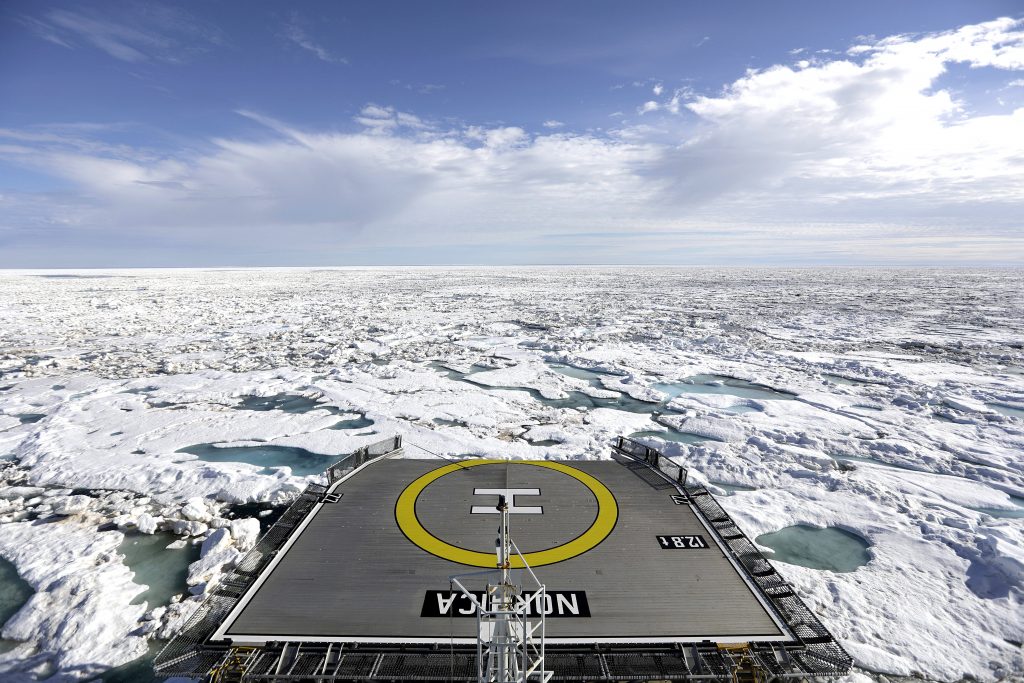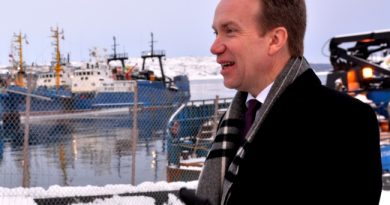Canada, U.S., Finland take step forward on ICE Pact plan to build icebreakers

Canada, the United States and Finland have taken a step toward building new icebreakers together, despite the breakdown in trade talks between Ottawa and the Trump administration.
Canada’s Ambassador to the United States Kirsten Hillman joined Homeland Security Secretary Kristi Noem and Finland’s Minister of Economic Affairs Sakari Puisto to sign a joint statement of intent in Washington on Tuesday to strengthen industrial co-operation and bolster the countries’ icebreaker fleets.
“There is no doubt that we face an increasingly dangerous world and it is important in these times to build on the relationships with our key allies,” Hillman said at the Department of Homeland Security headquarters.
The move indicates that U.S. President Donald Trump still supports the Icebreaker Collaboration Effort, known as the ICE Pact, which was signed under President Joe Biden.
The future of the ICE Pact was not clear after Trump’s election win, when the relationship between Canada and the United States was thrust into turmoil.
Trump in January dismissed Canada’s role in building the ships necessary for navigating ice-covered waters. The president claimed Canada wanted to “join us in the buying of icebreakers” and said “we don’t really want to have a partner in the buying of icebreakers.”
The Department of Homeland Security said in an October news release that the Trump administration signed an agreement with Finland to purchase four Arctic Security Cutters for the U.S Coast Guard. The ship’s design comes from Canadian company Seaspan Shipyards.

That same month, Trump called off trade negotiations with Ottawa, citing an Ontario-funded ad quoting former president Ronald Reagan criticizing tariffs.
Despite that, Hillman has said she has remained in contact with her American counterparts on many other issues.
Security and opportunities in the Arctic have long been priorities for Trump. Noem said Tuesday “the Arctic is the world’s last most wild frontier and our adversaries are racing to claim its strategic position and its rich natural resources.”
To thrive in the Arctic, Noem said, America needs icebreakers. She said that requires securing supply chains and reshoring manufacturing to the United States.
Noem said the ICE pact pools all three countries’ experience and resources to ensure icebreakers can be built quickly and on budget.
Noem pointed to Canada’s Chantier Davie, which announced in June plans to invest $1 billion in Texas shipyards. Davie also has operations in Québec and Finland.

Ottawa said in a news release that by pooling expertise and resources, Canada, the U.S. and Finland are expanding their icebreaker fleets to better address Arctic challenges.
Canada is also boosting its Arctic capabilities. It is building two new polar icebreakers for the Canadian Coast Guard.
Hillman laid out other ways that Canada and the United States work together to safeguard the North American perimeter, citing boosted border funding and a “generational” investment in defence.
To hit Canada with economy wide tariffs, Trump declared an emergency at the Canada-U.S. border over the flow of deadly fentanyl. Those tariffs do not apply to goods compliant with the Canada-U.S.-Mexico Agreement on trade.
U.S. government data shows a tiny volume of fentanyl is seized at America’s northern border compared to the border with Mexico.
When asked about Ottawa’s increased security efforts at the border, Noem said Canada has made strides but did not say whether it would be enough to end Trump’s tariffs.
“We have had some good progress and I appreciate their focus on that while we build on our national security partnerships,” she said.
Related stories from around the North:
Canada: Sanctions-evading Russian oil ships could pollute the Arctic, PM’s adviser warns, The Canadian Press
Denmark: Denmark, Greenland agree to build naval wharf in Nuuk amid growing Arctic focus, Eye on the Arctic
Finland: Canada wants to learn from Finland, Yle News
Iceland: Europe’s Von der Leyen strengthens Arctic security ties with Iceland during visit, Eye on the Arctic
Norway: German naval ships firing at Norwegian Arctic test range, The Independent Barents Observer
Russia: Russia trains coastal attack scenario 30 km from border with Norway, The Associated Press
Sweden: Sweden looking for Canadian partnership to ramp up fighter, surveillance plane production, Radio Sweden
United States: Russian warplanes detected flying near Alaska for ninth time this year, US military says, Eye on the Arctic



